Attached files
| file | filename |
|---|---|
| EX-99.2 - EXHIBIT 99.2 - SELECTA BIOSCIENCES INC | exhibit992eular2018poste.htm |
| EX-99.1 - EXHIBIT 99.1 - SELECTA BIOSCIENCES INC | exhibit991_pressrelease.htm |
| EX-10.1 - EXHIBIT 10.1 - SELECTA BIOSCIENCES INC | exhibit101_amendedandresta.htm |
| 8-K - 8-K - SELECTA BIOSCIENCES INC | selectabiosciences8k_june2.htm |

New SEL-212 Phase 2 Data Presented at EULAR June 15, 2018

Safe Harbor / Disclaimer Any statements in this presentation about the future expectations, plans and prospects of Selecta Biosciences, Inc. (“the company”), including without limitation, the progress of the Phase 1/2 clinical program of SEL-212, the ability of SVP-Rapamycin to mitigate unwanted immunogenicity and unlock the full potential of biologic therapies, whether the product profile of SEL-212 provides mitigation of ADAs, whether SEL-212 enables repeat dosing and sustained serum uric acid control, the potential of five monthly combination doses of SEL-212 to extend efficacy over the entire treatment period, when the company will advance to Phase 3 for SEL-212 (if at all), the ability of SEL-212 to provide better and more sustained serum uric acid control, fewer flares, and less frequent dosing compared with recent data reported with the current FDA-approved uricase therapy, the ability of the company’s SVP platform, including SVP-Rapamycin, to enable new therapies or to improve the efficacy or safety of existing biologics by mitigating immune response, when the company will conduct an End-of-Phase 2 meeting for SEL-212 if at all, the potential of SEL-212 to treat severe gout patients and resolve their debilitating symptoms, whether the FDA approves the company’s plan to provide combination therapy of SEL- 212 for the entire treatment period, whether the company will determine an appropriate dose regimen of SEL-212 for the Phase 3, whether SEL-212 has the potential to address the unmet needs of gout patients, whether patients receiving SEL-212 will be able to complete full therapy cycles over 6 months, whether SEL-212 data will continue to show low incidence of gout flares initially and over time during SEL-212 therapy, whether SEL-212 will continue to be generally well-tolerated, when the company will report further data from the Phase 2 trial, whether the data from patients receiving five monthly combination doses of SEL-212 will support the company’s plans for its Phase 3 trial, whether the company will conduct head to head studies versus Krystexxa or with patients who have failed on Krystexxa, the potential of the SVP-Rapamycin platform, generally, and other statements containing the words “anticipate,” “believe,” “continue,” “could,” “estimate,” “expect,” “hypothesize,” “intend,” “may,” “plan,” “potential,” “predict,” “project,” “should,” “target,” “would,” and similar expressions, constitute forward-looking statements within the meaning of The Private Securities Litigation Reform Act of 1995. Actual results may differ materially from those indicated by such forward-looking statements as a result of various important factors, including, but not limited to, the following: the uncertainties inherent in the initiation, completion and cost of clinical trials including their uncertain outcomes, the availability and timing of data from ongoing and future clinical trials and the results of such trials, whether preliminary results from a particular clinical trial will be predictive of the final results of that trial or whether results of early clinical trials will be indicative of the results of later clinical trials, the unproven approach of the company’s SVP technology, potential delays in enrollment of patients, undesirable side effects of the company’s product candidates, its reliance on third parties to manufacture its product candidates and to conduct its clinical trials, the company’s inability to maintain its existing or future collaborations or licenses, its inability to protect its proprietary technology and intellectual property, potential delays in regulatory approvals, the availability of funding sufficient for its foreseeable and unforeseeable operating expenses and capital expenditure requirements, substantial fluctuation in the price of its common stock, and other important factors discussed in the “Risk Factors” section of the company’s Quarterly Report on Form 10-Q filed with the Securities and Exchange Commission, or SEC, on May 9, 2018, and in other filings that the company makes with the SEC. In addition, any forward-looking statements included in this presentation represent the company’s views only as of the date of its publication and should not be relied upon as representing its views as of any subsequent date. The company specifically disclaims any obligation to update any forward-looking statements included in this presentation. 2

SEL-212 Phase 2 Overview and Summary of New Data Presented at EULAR Summary of new data presented at EULAR • 3-month data show SEL-212 product profile may provide: • Mitigation of ADAs enabling repeat dosing and sustained serum uric acid control: ~81% of patients with sUA <6 mg/dl • Low flare rate in the first month : 33% for new SEL-212 Cohorts; 27% for all SEL-212 Cohorts in the trial • Less frequent dosing: Monthly compared to weekly/bi-weekly dosing for FDA-approved uricase Next Steps for the SEL-212 Program • 5-monthly SEL-212 combination doses have potential to extend efficacy over entire treatment period • Patient cohorts are now receiving their 4th of 5 monthly doses of SEL-212 combination therapy • Data from patients receiving 5 monthly doses of SEL-212 to be presented at medical conference in Q3 • Phase 3 program expected to begin in 2018 3
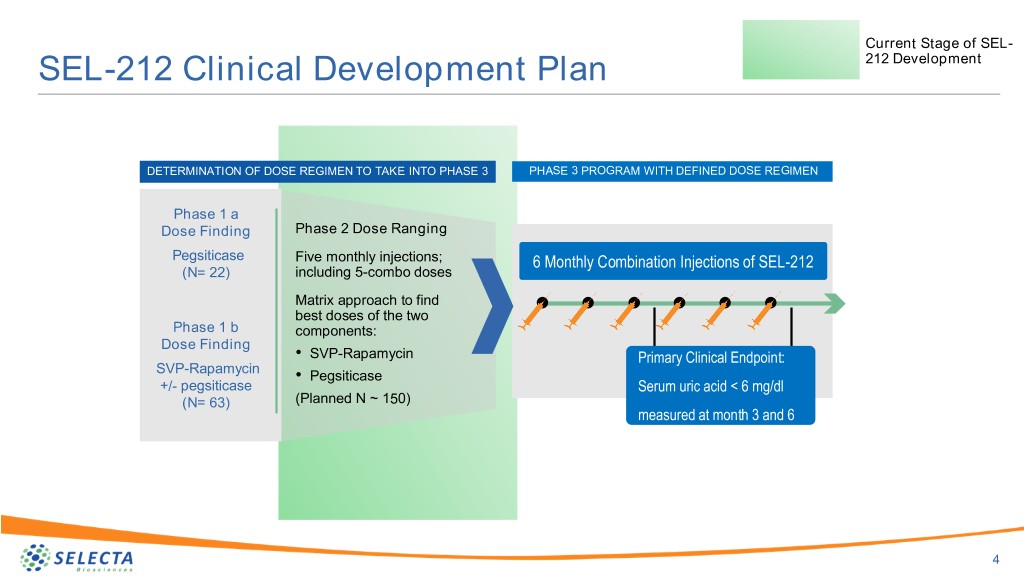
Current Stage of SEL- SEL-212 Clinical Development Plan 212 Development DETERMINATION OF DOSE REGIMEN TO TAKE INTO PHASE 3 PHASE 3 PROGRAM WITH DEFINED DOSE REGIMEN Phase 1 a Dose Finding Phase 2 Dose Ranging Pegsiticase Five monthly injections; 6 Monthly Combination Injections of SEL-212 (N= 22) including 5-combo doses Matrix approach to find best doses of the two Phase 1 b components: Dose Finding • SVP-Rapamycin Primary Clinical Endpoint: SVP-Rapamycin • Pegsiticase +/- pegsiticase Serum uric acid < 6 mg/dl (N= 63) (Planned N ~ 150) measured at month 3 and 6 4
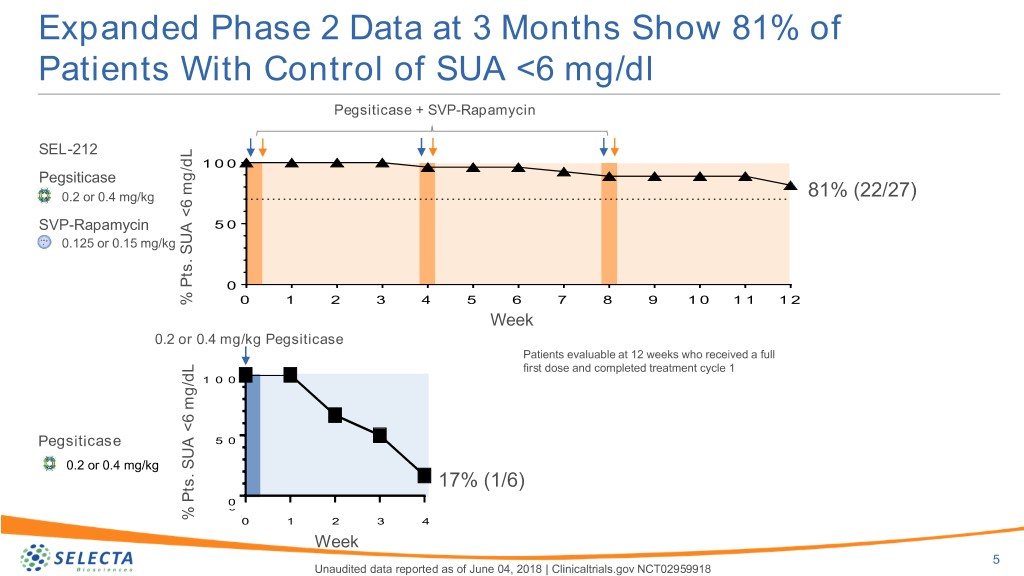
Expanded Phase 2 Data at 3 Months Show 81% of Patients With Control of SUA <6 mg/dl Pegsiticase + SVP-Rapamycin SEL-212 1 0 0 Pegsiticase 0.2 or 0.4 mg/kg 81% (22/27) SVP-Rapamycin 5 0 0.125 or 0.15 mg/kg 0 % Pts. SUA mg/dL SUA <6 Pts. % 0 1 2 3 4 5 6 7 8 9 1 0 1 1 1 2 Week 0.2 or 0.4 mg/kg Pegsiticase Patients evaluable at 12 weeks who received a full first dose and completed treatment cycle 1 1 0 0 1 0 0 5 0 Pegsiticase 5 0 0.2 or 0.4 mg/kg 17% (1/6) 0 0 % Pts. SUA mg/dL SUA <6 Pts. % 0 1 2 3 4 5 6 7 8 9 1 0 1 1 1 2 0 1 2 3 4 5 6 7 8 9 1 0 1 1 1 2 Week 5 Unaudited data reported as of June 04, 2018 | Clinicaltrials.gov NCT02959918

Cohort 10: 0.125 mg/kg of SEL-110 + 0.4 mg/kg of SEL-037 Patient 0.125 0.125 0.125 0 0 SEL-110 0.4 0.4 0.4 0.4 0.4 SEL-037 1 0 1 0 5 8 4 6 1 0 4 1 0 3 106-0060 2 0 1 0 2 1 0 1 0 5 8 4 6 1 0 102-0019 4 1 0 3 2 0 1 0 2 1 0 1 0 5 8 4 6 1 0 107-0012 4 3 1 0 2 0 1 0 2 1 0 1 0 5 7 of 8 evaluable patients 8 1 0 4 6 107-0014 Anti ) 4 1 0 3 2 0 1 0 2 (87.5%) maintained UA control 1 0 1 0 5 8 4 dL 6 1 0 111-0010 4 3 1 0 - after 3 monthly doses of SEL- 2 0 1 0 2 Uricase Antibody Titer 1 2 1 0 5 1 0 8 1 0 4 110 and SEL-037 6 110-0031 3 4 1 0 2 0 1 0 2 1 0 1 0 5 8 4 107-0024 6 1 0 4 1 0 3 2 0 1 0 2 1 0 1 0 5 8 4 106-0061 6 1 0 4 A 1 0 3 2 0 1 0 2 1 0 1 0 5 8 4 111-0009 6 F 1 0 4 1 0 3 2 0 1 0 2 1 0 1 0 5 Stopping rules met 8 A 4 112-0002 6 1 0 4 3 Serum Uric Acid (mg/ Acid Uric Serum D 1 0 2 0 1 0 2 1 0 1 0 5 D Withdrawn due to protocol deviation 8 4 112-0001 6 1 0 4 E 3 1 0 2 0 1 0 2 5 Discontinuation due to infusion reaction 1 0 1 0 E 8 4 111-0011 6 1 0 4 D 1 0 3 2 0 1 0 2 Withdrawal of consent 1 0 1 0 5 F 8 4 117-0005 6 1 0 4 1 0 3 2 G 0 1 0 2 SAE; non-study drug related 5 G 1 0 1 0 8 4 107-0022 6 1 0 4 H 3 1 0 2 0 1 0 2 H Discontinuation due to TEAE 0 1 2 3 4 5 6 7 8 9 1 0 1 1 1 2 1 3 1 4 1 5 1 6 1 7 1 8 1 9 2 0 Week 6

Cohort 11: 0.15 mg/kg of SEL-110 + 0.2 mg/kg of SEL-037 0.15 0.15 0.15 0 0 SEL-110 Patient 0.2 0.2 0.2 0.2 0.2 SEL-037 1 0 1 0 5 8 4 6 1 0 117-0003 4 3 1 0 2 0 1 0 2 1 0 1 0 5 8 4 6 1 0 106-0086 3 4 1 0 2 0 1 0 2 1 0 1 0 5 8 of 10 evaluable patients 8 4 111-0018 6 1 0 4 1 0 3 2 (80%) maintained UA control 0 1 0 2 1 0 1 0 5 8 Anti 4 110-0034 ) 6 1 0 after 3 monthly doses of SEL- 4 1 0 3 2 0 1 0 2 dL 1 0 1 0 5 110 and SEL-037 8 4 6 1 0 - 106-0092 Uricase Antibody Titer 4 1 0 3 2 0 1 0 2 1 0 1 0 5 8 4 106-0093 6 1 0 4 1 0 3 2 0 1 0 2 1 0 1 0 5 8 4 102-0024 6 1 0 4 1 0 3 2 0 1 0 2 1 0 1 0 5 8 4 104-2021 6 1 0 4 1 0 3 2 0 1 0 2 1 0 1 0 5 8 4 104-2026 6 1 0 4 A 3 1 0 2 0 1 0 2 1 0 1 0 5 8 4 103-0022 6 D A 1 0 4 1 0 3 2 2 Serum Uric Acid (mg/ Acid Uric Serum 0 1 0 1 0 1 0 5 8 E 4 6 1 0 106-0084 4 3 Stopping rules met 1 0 A 2 0 1 0 2 1 0 1 0 5 8 Withdrawn due to protocol deviation 4 6 F 1 0 D 103-0025 4 1 0 3 2 0 1 0 2 Discontinuation due to infusion reaction 1 0 1 0 5 E 8 4 6 D 1 0 111-0019 4 1 0 3 Withdrawal of Consent 2 F 0 1 0 2 0 1 2 3 4 5 6 7 8 9 1 0 1 1 1 2 1 3 1 4 1 5 1 6 1 7 1 8 1 9 2 0 Week 7
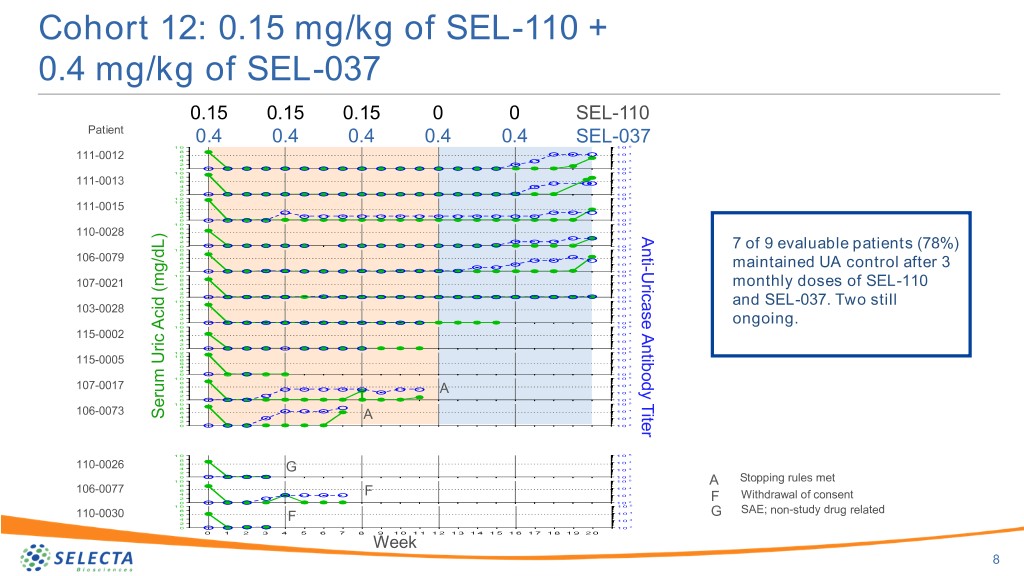
Cohort 12: 0.15 mg/kg of SEL-110 + 0.4 mg/kg of SEL-037 0.15 0.15 0.15 0 0 SEL-110 Patient 0.4 0.4 0.4 0.4 0.4 SEL-037 1 0 1 0 5 8 4 111-0012 6 1 0 4 1 0 3 2 0 1 0 2 1 0 1 0 5 8 4 111-0013 6 1 0 4 1 0 3 2 0 1 0 2 1 2 1 0 5 1 0 8 1 0 4 111-0015 6 4 1 0 3 2 0 1 0 2 1 0 1 0 5 8 4 6 1 0 110-0028 Anti ) 4 1 0 3 2 0 1 0 2 5 7 of 9 evaluable patients (78%) 1 0 1 0 8 4 106-0079 dL 6 1 0 4 3 1 0 - 2 maintained UA control after 3 0 1 0 2 Uricase Antibody Titer 1 0 1 0 5 8 4 107-0021 6 1 0 monthly doses of SEL-110 4 1 0 3 2 0 1 0 2 1 0 1 0 5 8 and SEL-037. Two still 4 103-0028 6 1 0 4 1 0 3 2 0 1 0 2 ongoing. 1 0 1 0 5 8 4 115-0002 6 1 0 4 1 0 3 2 0 1 0 2 1 2 1 0 5 1 0 8 1 0 4 115-0005 6 4 1 0 3 2 0 1 0 2 1 0 1 0 5 8 4 107-0017 6 1 0 4 A 1 0 3 2 0 1 0 2 1 0 1 0 5 8 4 106-0073 6 1 0 Serum Uric Acid (mg/ Acid Uric Serum 4 A 1 0 3 2 0 1 0 2 1 0 1 0 5 8 4 6 1 0 110-0026 4 3 G 1 0 2 0 1 0 2 1 0 1 0 5 A Stopping rules met 8 4 106-0077 6 1 0 4 F 1 0 3 2 Withdrawal of consent 2 F 0 1 0 1 0 1 0 5 8 4 SAE; non-study drug related 110-0030 6 1 0 G 4 F 1 0 3 2 0 1 0 2 0 1 2 3 4 5 6 7 8 9 1 0 1 1 1 2 1 3 1 4 1 5 1 6 1 7 1 8 1 9 2 0 Week 8

Updated EULAR-Cohort Data Continue to Show Low Overall Incidence of Gout Flares Percent patients with gout flare by treatment month 6 0 50 4 0 33 19 2 0 8 % of Patients w/Flare w/Flare PatientsPatientsofof % % 0 month 1 1 2 3 Pegsiticase Alone SEL-212* * Pegsiticase 0.2 or 0.4 mg/kg with SVP-Rapamycin 0.125 or 0.15 mg/kg; Patients evaluable at 12 weeks who received a full first dose and completed treatment cycle 1; Month 1 N=27, Month 2 N=26, Month 3 N=24 9 Unaudited data reported as of May 29, 2018 | Clinicaltrials.gov NCT02959918
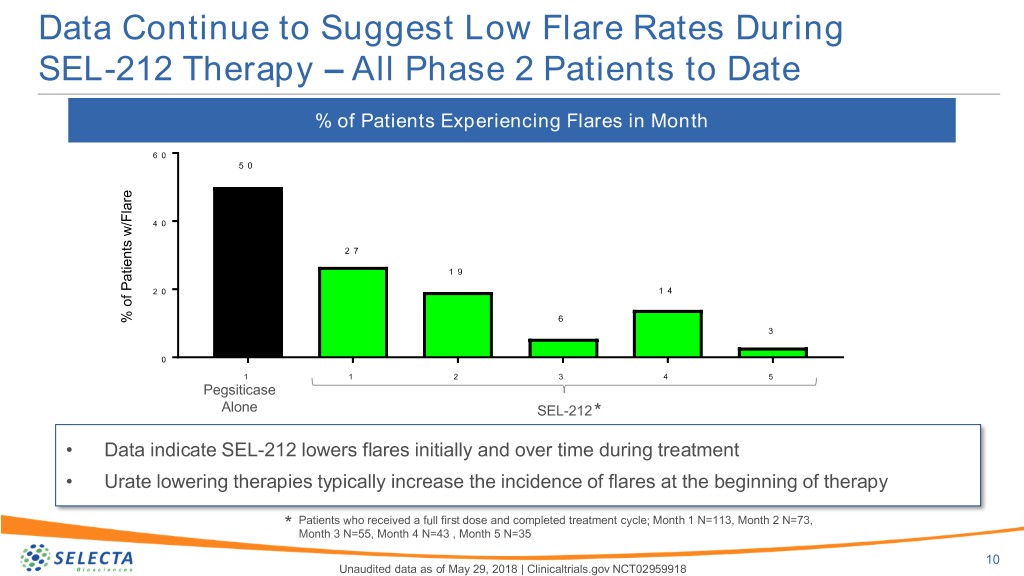
Data Continue to Suggest Low Flare Rates During SEL-212 Therapy – All Phase 2 Patients to Date % of Patients Experiencing Flares in Month 6 0 5 0 4 0 2 7 1 9 2 0 1 4 % of Patients w/Flare Patients of % 6 3 0 1 1 2 3 4 5 Pegsiticase Alone SEL-212* • Data indicate SEL-212 lowers flares initially and over time during treatment • Urate lowering therapies typically increase the incidence of flares at the beginning of therapy * Patients who received a full first dose and completed treatment cycle; Month 1 N=113, Month 2 N=73, Month 3 N=55, Month 4 N=43 , Month 5 N=35 10 Unaudited data as of May 29, 2018 | Clinicaltrials.gov NCT02959918
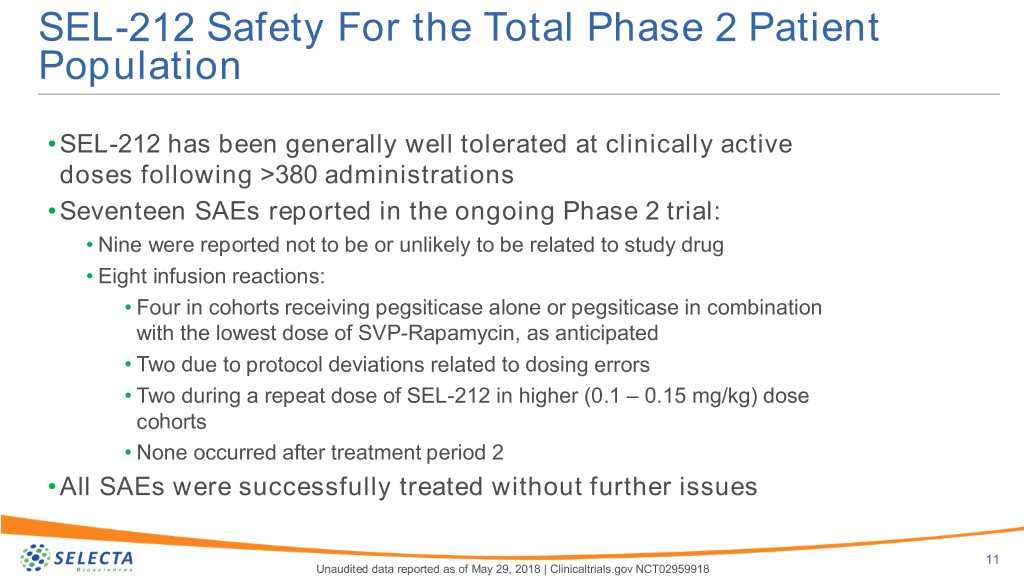
SEL-212 Safety For the Total Phase 2 Patient Population •SEL-212 has been generally well tolerated at clinically active doses following >380 administrations •Seventeen SAEs reported in the ongoing Phase 2 trial: • Nine were reported not to be or unlikely to be related to study drug • Eight infusion reactions: • Four in cohorts receiving pegsiticase alone or pegsiticase in combination with the lowest dose of SVP-Rapamycin, as anticipated • Two due to protocol deviations related to dosing errors • Two during a repeat dose of SEL-212 in higher (0.1 – 0.15 mg/kg) dose cohorts • None occurred after treatment period 2 •All SAEs were successfully treated without further issues 11 Unaudited data reported as of May 29, 2018 | Clinicaltrials.gov NCT02959918

SEL-212 EULAR-Cohort Data Compared to KRYSTEXXA® ACR Data Category SEL-212 (12 weeks) KRYSTEXXA® (16 weeks)+ sUA control 81%++ 44% Gout flare % 33% 52% Dosing regimen 3 monthly injections 3 weekly followed by 7 bi-weekly injections +Krystexxa results from “Initial Clinical Study to determine whether a tolerizing regimen of pegloticase can increase frequency of subjects having sustained lowering of serum urate.” Kenneth E. Saag, Mitchell Finemann, Alan Kivitz, Herbert Baraf, Roy Fleishmann, Arthur Kavanaugh, and Peter Lipsky; ACR Poster 2017 ++ Defined as % of evaluable patients at 12 weeks with sUA <6 mg/dl who received a full first dose and completed treatment cycle 1 12 Unaudited SEL-212 data reported as of June 1, 2018 | Clinicaltrials.gov NCT02959918

Next Step for SEL-212 in 2018 SEL-212 PHASE 3 PROGRAM • Data expected in third quarter from patients receiving 6 Monthly Combination Injections of SEL-212 against five combination placebo doses of SEL-212 • Patients now receiving 4th of 5 expected combination doses • Phase 3 program Primary Clinical Endpoint: expected to begin in 2018 Serum uric acid < 6 mg/dl measured at month 3 and 6 Additional possible studies include: • Head to Head versus Krystexxa • Krystexxa Failures

We thank all of the patients that participated in our clinical trials. We are very grateful to the clinical trial site investigators and their staff.
